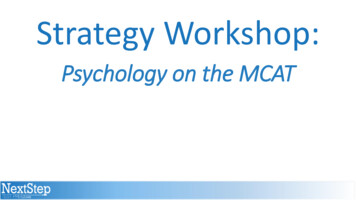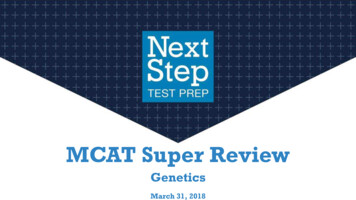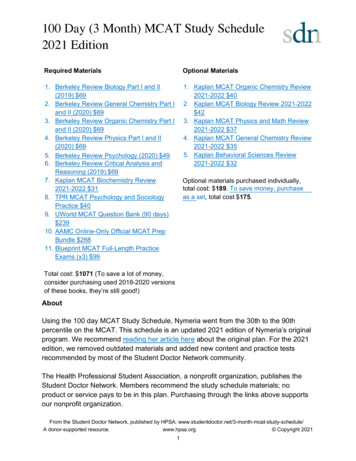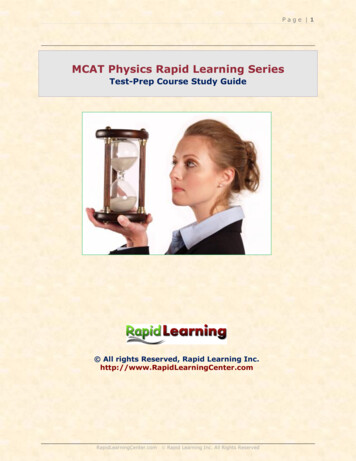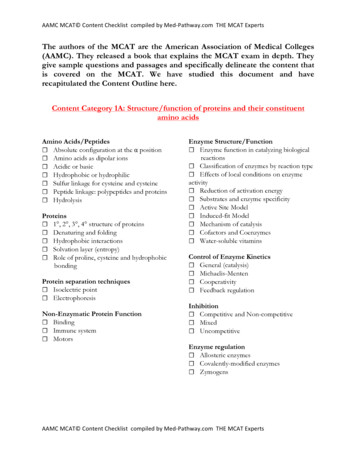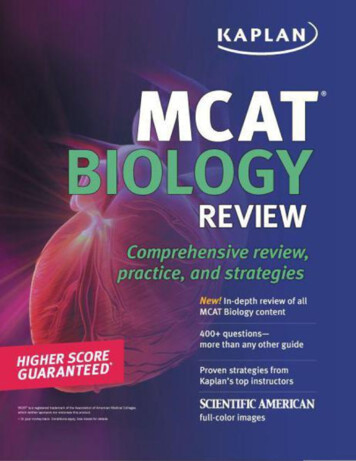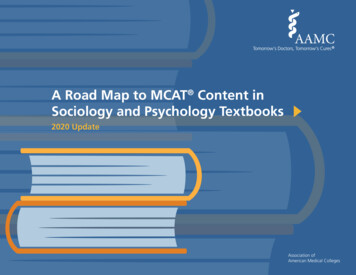
Transcription
A Road Map to MCAT Content inSociology and Psychology Textbooks2020 UpdateAssociation ofAmerican Medical Colleges
A Road Map to MCAT Content in Sociology and Psychology TextbooksContentsIntroduction. 1Textbooks Included in This Road Map. 2Foundational Concept 6: Biological, psychological, and sociocultural factorsinfluence the ways that individuals perceive, think about, and react to the world. 3Content Category 6A: Sensing the environment. 4Content Category 6B: Making sense of the environment. 6Content Category 6C: Responding to the world. 9Foundational Concept 7: Biological, psychological, and sociocultural factorsinfluence behavior and behavior change. 11Content Category 7A: Individual influences on behavior. 12Content Category 7B: Social processes that influence human behavior. 16Content Category 7C: Attitude and behavior change. 18Foundational Concept 8: Psychological, sociocultural, and biological factorsinfluence the way we think about ourselves and others, as well as howwe interact with others. 20Content Category 8A: Self Identity . 21Content Category 8B: Social thinking . 22Content Category 8C: Social interactions . 23Foundational Concept 9: Cultural and social differences influence well-being. 25Content Category 9A: Understanding social structure. 26Content Category 9B: Demographic characteristics and processes. 28Foundational Concept 10: Social stratification and access to resources influencewell-being. 30Content Category 10A: Social inequality. 312Association ofAmerican Medical Colleges
A Road Map to MCAT Content in Sociology and Psychology TextbooksIntroductionPrepare for the MCAT exam with this official Road Map to MCAT Contentin Sociology and Psychology Textbooks. We reached out to publishers ofsociology and psychology textbooks and asked them to identify where thefoundational concepts and content categories tested on the MCAT exam canbe found within their textbooks.Four textbooks are included in this resource, and two others will be addedsoon. We will update it as we hear from publishers of other textbooks.DisclaimerAll references to the textbook and corresponding content information wereself-reported by the publishers. The AAMC has not verified the informationfor accuracy or relevance. This information is not intended to prescribe aprogram of study for the MCAT exam, promote a textbook, or guaranteesuccess on the exam.Invitation to Textbook PublishersIf you are a publisher of an introductory textbook on sociology or psychologyand would like to add your publication and information to this referencedocument, please email mcatprep@aamc.org.The Medical College Admission Test (MCAT ) is a program of the AAMC.1Association ofAmerican Medical Colleges
A Road Map to MCAT Content in Sociology and Psychology TextbooksTextbooks Included in This Road MapTextbookLinkMapping included in this road mapBallantine JH, Roberts KA, Korgen KO. Our Social World. 7th ed. l-world/book259286Oaks, CA: SAGE Publications, Inc.; 2020.Cragun RT, Cragun DL, Konieczny P. Introduction to Sociology. Wikibooks; Free and open ion to SociologyMyers DG, DeWall CN. Exploring Psychology. 11th ed. New York, NY:Worth Publishers; product/ExploringPsychology/p/1319104193Newman DM. Sociology: Exploring the Architecture of Everyday Life.13th ed. Thousand Oaks, CA: Sage Publications, Inc.; 2021.https://edge.sagepub.com/newman13eMapping coming soon2Spielman RM, et al. Psychology. Open Stax. Rice University; 2014.Free and open gyGriffiths H, et al. Introduction to Sociology 2e. Open Stax. Rice University;2020.Free and open tion-sociology-2eAssociation ofAmerican Medical Colleges
A Road Map to MCAT Content in Sociology and Psychology TextbooksFoundational Concept 6: Biological, psychological, and sociocultural factorsinfluence the ways that individuals perceive, think about, and react to the world.The ways we sense, perceive, think about, and react to stimuli affect our experiences. Foundational concept 6 focuses on these components ofexperience, starting with the initial detection and perception of stimuli through cognition and continuing to emotion and stress.Content Categories: Category 6A focuses on the detection and perception of sensory information. Category 6B focuses on cognition, including our ability to attend to the environment, think about and remember what we experience, anduse language to communicate with others. Category 6C focuses on how we process and experience emotion and stress.With these building blocks, medical students will be able to learn about the ways cognitive and perceptual processes influence theirunderstanding of health and illness.3Association ofAmerican Medical Colleges
A Road Map to MCAT Content in Sociology and Psychology TextbooksContent Category 6A: Sensing the environmentPsychological, sociocultural, and biological factors affect our sensation and perception of the world. All sensory processing begins with firstdetecting a stimulus in the environment through sensory cells, receptors, and biological pathways.After collecting sensory information, we then interpret and make sense of it. Although sensation and perception are distinct functions, theyare both influenced by psychological, social, and biological factors and therefore become almost indistinguishable in practice. This complexity isilluminated by examining human sight, hearing, touch, taste, and smell.The content in this category covers sensation and perception across all human senses.Topic4Our Social WorldIntroductionto SociologySociology: Exploring theArchitecture of Everyday LifeExploring PsychologySensory Processing (PSY, BIO) Sensation› Threshold› Weber’s Law (PSY)› Signal detection theory (PSY)› Sensory adaptation› Psychophysics Sensory receptors› Sensory pathways› Types of sensory receptorsCh. 6, pp. 189-232Vision (PSY, BIO) Structure and function of the eye Visual processing› Visual pathways in the brain› Parallel processing (PSY)› Feature detection (PSY)Ch. 6, pp. 199-215Hearing (PSY, BIO) Structure and function of the ear Auditory processing (e.g., auditory pathways in the brain) Sensory reception by hair cellsCh. 6, pp. 216-220Association ofAmerican Medical Colleges
A Road Map to MCAT Content in Sociology and Psychology TextbooksTopic5Our Social WorldIntroductionto SociologySociology: Exploring theArchitecture of Everyday LifeExploring PsychologyOther Senses (PSY, BIO) Somatosensation (e.g., pain perception) Taste (e.g., taste buds (chemoreceptors) that detectspecific chemicals) Smell› Olfactory cells (chemoreceptors) that detect specificchemicals› Pheromones (BIO)› Olfactory pathways in the brain (BIO) Kinesthetic sense (PSY) Vestibular senseCh. 6, pp. 220-228Perception (PSY) Bottom-up/top-down processing Perceptual organization (e.g., depth, form, motion,constancy) Gestalt principlesCh. 6, pp. 189-232Association ofAmerican Medical Colleges
A Road Map to MCAT Content in Sociology and Psychology TextbooksContent Category 6B: Making sense of the environmentThe way we think about the world depends on our awareness, thoughts, knowledge, and memories. It is also influenced by our ability to solveproblems, make decisions, form judgments, and communicate. Psychological, sociocultural, and biological influences determine the developmentand use of these different yet convergent processes.Biological factors underlie the mental processes that create our reality, shape our perception of the world, and influence the way we perceive andreact to every aspect of our lives.The content in this category covers critical aspects of cognition — including consciousness, cognitive development, problem-solving and decisionmaking, intelligence, memory, and language.Topic6Our Social WorldIntroductionto SociologySociology: Exploring theArchitecture of Everyday LifeExploring PsychologyAttention (PSY) Selective attention Divided attentionCh. 3, pp. 81-83Cognition (PSY) Information-processing model Cognitive development› Piaget’s stages of cognitive development› Cognitive changes in late adulthood› Role of culture in cognitive development› Influence of heredity and environment on cognitivedevelopment Biological factors that affect cognition (PSY, BIO) Problem-solving and decision-making› Types of problem-solving› Barriers to effective problem-solving› Approaches to problem-solving› Heuristics and biases (e.g., overconfidence, beliefperseverance) Intellectual functioning› Theories of intelligence› Influence of heredity and environment on intelligence› Variations in intellectual abilityCh. 1, pp. 16-17Ch. 2, pp. 70-75Ch. 4, pp. 119-162Ch. 5, pp. 168-172Ch. 8, pp. 268-269Ch. 9, pp. 315-332, 336-346Ch. 10, pp. 378-380Ch. 13, pp. 489-491Association ofAmerican Medical Colleges
A Road Map to MCAT Content in Sociology and Psychology TextbooksTopicConsciousness (PSY) States of consciousness› Alertness (PSY, BIO)› Sleep Stages of sleep Sleep cycles and changes to sleep cycles Sleep and circadian rhythms (PSY, BIO) Dreaming Sleep-wake disorders› Hypnosis and meditation Consciousness-altering drugs› Types of consciousness-altering drugs and their effectson the nervous system and behavior› Drug addiction and the reward pathway in the brainMemory (PSY) Encoding› Process of encoding information› Processes that aid in encoding memories Storage› Types of memory storage (e.g., sensory, working,long-term)› Semantic networks and spreading activation Retrieval› Recall, recognition, and relearning› Retrieval cues› The role of emotion in retrieving memories (PSY, BIO)› Processes that aid retrieval Forgetting› Aging and memory› Memory dysfunctions (e.g., Alzheimer’s disease,Korsakoff’s syndrome)› Decay› Interference› Memory construction and source monitoring Changes in synaptic connections underlie memory andlearning (PSY, BIO)› Neural plasticity› Memory and learning› Long-term potentiation7Our Social WorldIntroductionto SociologySociology: Exploring theArchitecture of Everyday LifeCh. 1, Taking a New Look at a FamiliarWorld, pp. 5-7 (“A sociology of sleep”)Exploring PsychologyCh. 3, pp. 79-114Ch. 2, pp. 39, 44, 64Ch. 4, pp. 152-154Ch. 6, pp. 193, 227Ch. 8, pp. 265-296Ch. 11, p. 401Association ofAmerican Medical Colleges
A Road Map to MCAT Content in Sociology and Psychology TextbooksTopicLanguage (PSY) Theories of language development (e.g., learning,Nativist, Interactionist) Influence of language on cognition Brain areas that control language and speech (PSY, BIO)8Our Social WorldIntroductionto SociologySociology: Exploring theArchitecture of Everyday LifeCh. 3, Building Reality: The SocialConstruction of Knowledge, pp. 50-53(“Culture and language”)Exploring PsychologyCh. 9, pp. 311-318Ch. 5, Building Identity: Socialization,pp. 113-118 (“The acquisition of self”)Association ofAmerican Medical Colleges
A Road Map to MCAT Content in Sociology and Psychology TextbooksContent Category 6C: Responding to the worldWe experience a barrage of environmental stimuli throughout the course of our lives. In many cases, environmental stimuli trigger physiologicalresponses, such as an elevated heart rate, increased perspiration, or heightened feelings of anxiety. How we perceive and interpret thesephysiological responses is complex and influenced by psychological, sociocultural, and biological factors.Emotional responses, such as feelings of happiness, sadness, anger, or stress, are often born out of our interpretation of this interplay ofphysiological responses. Our experience with emotions and stress not only affects our behavior, but also shapes our interactions with others.The content in this category covers the basic components and theories of emotion and their underlying psychological, sociocultural, andbiological factors. It also addresses stress, stress outcomes, and stress management.TopicEmotion (PSY) Three components of emotion (i.e., cognitive,physiological, behavioral) Universal emotions (i.e., fear, anger, happiness, surprise,joy, disgust, sadness) Adaptive role of emotion Theories of emotion› James-Lange theory› Cannon-Bard theory› Schachter-Singer theory The role of biological processes in perceiving emotion(PSY, BIO)› Brain regions involved in the generation andexperience of emotions› The role of the limbic system in emotion› Emotion and the autonomic nervous system› Physiological markers of emotion (signatures ofemotion)9Our Social WorldIntroductionto SociologySociology: Exploring theArchitecture of Everyday LifeCh. 4, Building Order: Culture andHistory, pp. 95-96 (“Can Culture tellyou what to feel?”Exploring PsychologyCh. 2, pp. 55-56Ch. 4, p. 142Ch. 8, pp. 277-278Ch. 10, pp. 367-395Association ofAmerican Medical Colleges
A Road Map to MCAT Content in Sociology and Psychology TextbooksTopicStress (PSY) The nature of stress› Appraisal› Different types of stressors (e.g., cataclysmic events,personal)› Effects of stress on psychological functions Stress outcomes, response to stressors› Physiological (PSY, BIO)› Emotional› Behavioral Managing stress (e.g., exercise, relaxation, spirituality)10Our Social WorldIntroductionto SociologySociology: Exploring theArchitecture of Everyday LifeExploring PsychologyCh. 11, pp. 384-406Ch. 14, pp. 509-510Association ofAmerican Medical Colleges
A Road Map to MCAT Content in Sociology and Psychology TextbooksFoundational Concept 7: Biological, psychological, and sociocultural factorsinfluence behavior and behavior change.Human behavior is complex and often surprising, differing across individuals in the same situation and within an individual across differentsituations. A full understanding of human behavior requires knowledge of the interplay between psychological, sociocultural, and biologicalfactors related to behavior. This interplay has important implications for the way we behave and the likelihood of behavior change.Foundational Concept 7 focuses on individual and social determinants of behavior and behavior change.Content Categories: Category 7A focuses on the individual psychological and biological factors that affect behavior. Category 7B focuses on how social factors, such as groups and social norms, affect behavior. Category 7C focuses on how learning affects behavior, as well as the role of attitude theories in behavior and behavior change.With these building blocks, medical students will be able to learn how behavior can either support health or increase risk for disease.11Association ofAmerican Medical Colleges
A Road Map to MCAT Content in Sociology and Psychology TextbooksContent Category 7A: Individual influences on behaviorA complex interplay of psychological and biological factors shapes behavior. Biological structures and processes serve as the pathways bywhich bodies carry out activities. They also affect predispositions to behave in certain ways, shape personalities, and influence the likelihood ofdeveloping psychological disorders. Psychological factors also affect behavior and, consequently, health and well-being.The content in this category covers biological bases of behavior, including the effect of genetics and how the nervous and endocrine systemsaffect behavior. It also addresses how personality, psychological disorders, motivation, and attitudes affect behavior. Some of these topics arelearned in the context of nonhuman animal species.12Association ofAmerican Medical Colleges
A Road Map to MCAT Content in Sociology and Psychology TextbooksTopicBiological Bases of Behavior (PSY, BIO) The nervous system› Neurons (e.g., the reflex arc)› Neurotransmitters› Structure and function of the peripheral nervoussystem› Structure and function of the central nervous system The brain› Forebrain› Midbrain› Hindbrain› Lateralization of cortical functions› Methods used in studying the brain The spinal cord Neuronal communication and its influence on behavior(PSY) Influence of neurotransmitters on behavior (PSY) The endocrine system› Components of the endocrine system› Effects of the endocrine system on behavior Behavioral genetics› Genes, temperament, and heredity› Adaptive value of traits and behaviors› Interaction between heredity and environmentalinfluences Influence of genetic and environmental factors on thedevelopment of behaviors› Experience and behavior (PSY)› Regulatory genes and behavior (BIO)› Genetically based behavioral variation in naturalpopulations Human physiological development (PSY)› Prenatal development› Motor development› Developmental changes in adolescence13Our Social WorldIntroductionto SociologySociology: Exploring theArchitecture of Everyday LifeCh. 5, pp. 111-113Exploring PsychologyCh. 1, pp. 8-9Ch. 2, pp. 37-78Ch. 4, pp. 115-160Ch. 9, pp. 336-337, 41-343Ch. 14, pp. 483, 495-496Association ofAmerican Medical Colleges
A Road Map to MCAT Content in Sociology and Psychology TextbooksTopicOur Social WorldIntroductionto SociologySociology: Exploring theArchitecture of Everyday LifePersonality (PSY) Theories of personality› Psychoanalytic perspective› Humanistic perspective› Trait perspective› Social cognitive perspective› Biological perspective› Behaviorist perspective Situational approach to explaining behaviorPsychological Disorders (PSY) Understanding psychological disorders› Biomedical vs. biopsychosocial approaches› Classifying psychological disorders› Rates of psychological disorders Types of psychological disorders› Anxiety disorders› Obsessive-compulsive disorder› Trauma- and stressor-related disorders› Somatic symptom and related disorders› Bipolar and related disorders› Depressive disorders› Schizophrenia› Dissociative disorders› Personality disorders Biological bases of nervous system disorders (PSY, BIO)› Schizophrenia› Depression› Alzheimer’s disease› Parkinson’s disease› Stem cell-based therapy to regenerate neurons in thecentral nervous system (BIO)14Exploring PsychologyCh. 13, pp. 461-492Ch. 8, Constructing Difference:Social Deviance, pp. 236-241 (“Themedicalization of deviance”)Ch. 2, pp. 44, 64Ch. 8, p. 279Ch. 14, pp. 493-534Association ofAmerican Medical Colleges
A Road Map to MCAT Content in Sociology and Psychology TextbooksTopic15Our Social WorldIntroductionto SociologySociology: Exploring theArchitecture of Everyday LifeExploring PsychologyMotivation (PSY) Factors that influence motivation› Instinct› Arousal› Drives (e.g., negative-feedback systems) (PSY, BIO)› Needs Theories that explain how motivation affects humanbehavior› Drive reduction theory› Incentive theory› Other theories (e.g., cognitive, need-based) Biological and sociocultural motivators that regulatebehavior (e.g., hunger, sex drive, substance addiction)Ch. 3, pp. 101-102Ch. 5, pp. 165-187Ch. 10, pp. 348-367Attitudes (PSY) Components of attitudes (i.e., cognitive, affective,behavioral) The link between attitudes and behavior› Processes by which behavior influences attitudes (e.g.,foot-in-the door phenomenon, role-playing effects)› Processes by which attitudes influence behavior› Cognitive dissonance theoryCh. 12, pp. 415-460Association ofAmerican Medical Colleges
A Road Map to MCAT Content in Sociology and Psychology TextbooksContent Category 7B: Social processes that influence human behaviorMany social processes influence human behavior; in fact, the mere presence of other individuals can influence our behavior. Groups and socialnorms also exert influence over our behavior. Oftentimes, social processes influence our behavior through unwritten rules that define acceptableand unacceptable behavior in society.Our understanding of groups and social norms is learned through the process of socialization. What we learn about the groups and society towhich we belong affects our behavior and influences our perceptions and interactions with others.The content in this category covers how the presence of others, group decision-making processes, social norms, and socialization shape ourbehavior.TopicHow the Presence of Others Affects IndividualBehavior (PSY) Social facilitation Deindividuation Bystander effect Social loafing Social control (SOC) Peer pressure (PSY, SOC) Conformity (PSY, SOC) Obedience (PSY, SOC)GroupsGroup Decision-Making Processes (PSY, SOC) Group polarization (PSY) GroupthinkGroupsNormative and Nonnormative Behavior (SOC) Social norms (PSY, SOC)› Sanctions (SOC)› Folkways, mores, and taboos (SOC)› Anomie (SOC) Deviance› Perspectives on deviance (e.g., differential association,labeling theory, strain theory) Aspects of collective behavior (e.g., fads, mass hysteria,riots)16Introductionto SociologyOur Social WorldCh. 3: Society and CultureCh. 6: Deviance and SocialControlCh. 9: Gender StratificationDevianceSociology: Exploring theArchitecture of Everyday LifeCh. 2, Seeing and ThinkingSociologically, pp. 22-25 (“Socialinfluence: the impact of other peopleon our everyday lives”)Exploring PsychologyCh. 3, p. 112Ch. 4, pp. 146-148Ch. 12, pp. 421-434, 453455Ch. 12, pp. 429-434Ch. 4, Building Order: Culture andHistoryCh. 8, Constructing Difference: SocialDevianceCh. 5, p. 170, 175Ch. 12, pp. 421, 423-425,430-431, 455Ch. 13, pp. 489-491Ch. 14, pp. 494, 496-499Association ofAmerican Medical Colleges
A Road Map to MCAT Content in Sociology and Psychology TextbooksTopicSocialization (PSY, SOC) Agents of socialization (e.g., the family, mass media,peers, workplace)17Our Social WorldCh. 4: SocializationCh. 9: Gender StratificationIntroductionto SociologySocializationSociology: Exploring theArchitecture of Everyday LifeCh. 5, Building Identity: SocializationExploring PsychologyCh. 4, pp. 132-140, 145-150Ch. 5, pp. 168-171, 177-178Ch. 10, pp. 352-357Ch. 12, pp. 443-445, 455Association ofAmerican Medical Colleges
A Road Map to MCAT Content in Sociology and Psychology TextbooksContent Category 7C: Attitude and behavior changeLearning is a relatively permanent change in behavior brought about by experience. There are a number of different types of learning, whichinclude habituation as well as associative, observational, and social learning.Although people can learn new behaviors and change their attitudes, psychological, environmental, and biological factors influence whetherthose changes will be short-term or long-term. Understanding how people learn new behaviors and change their attitudes and which conditionsaffect learning helps us understand behavior and our interactions with others.The content in this category covers learning and theories of attitude and behavior change. This includes the elaboration likelihood model andsocial cognitive theory.Topic18Our Social WorldIntroductionto SociologySociology: Exploring theArchitecture of Everyday LifeExploring PsychologyHabituation and Dishabituation (PSY)Ch. 5, pp. 540-543Associative Learning (PSY) Classical conditioning (PSY, BIO)› Neutral, conditioned, and unconditioned stimuli› Conditioned and unconditioned response› Processes: acquisition, extinction, spontaneousrecovery, generalization, discrimination Operant conditioning (PSY, BIO)› Processes of shaping and extinction› Types of reinforcement: positive, negative, primary,conditional› Reinforcement schedules: fixed-ratio, variable-ratio,fixed-interval, variable-interval› Punishment› Escape and avoidance learning The role of cognitive processes in associative learning Biological processes that affect associative learning (e.g.,biological predispositions, instinctive drift) (PSY, BIO)Ch. 7, pp. 236-257Ch. 11, pp. 396-397Ch. 15, pp. 540-543Association ofAmerican Medical Colleges
A Road Map to MCAT Content in Sociology and Psychology TextbooksTopic19Our Social WorldIntroductionto SociologySociology: Exploring theArchitecture of Everyday LifeExploring PsychologyObservational Learning (PSY) Modeling Biological processes that affect observational learning› Mirror neurons› Role of the brain in experiencing vicarious emotions Applications of observational learning to explainindividual behaviorCh. 6, p. 223Ch. 7, pp. 258-264Ch. 12, pp. 443-445Theories of Attitude and Behavioral Change (PSY) Elaboration likelihood model Social cognitive theory Factors that affect attitude change (e.g., changingbehavior, characteristics of the message and target,social factors)Ch. 12, p. 418Ch. 13, pp. 482-485Ch. 15, pp. 537-548Association ofAmerican Medical Colleges
A Road Map to MCAT Content in Sociology and Psychology TextbooksFoundational Concept 8: Psychological, sociocultural, and biological factorsinfluence the way we think about ourselves and others, as well as how weinteract with others.The connection between how people think about themselves and others is complex and affects social interactions. The interplay betweenthoughts about ourselves, thoughts about others, and our biology has important implications for our sense of self and interpersonal relationships.Foundational Concept 8 focuses on the physical, cognitive, and social components of our identity, as well as how these components influence theway we think about and interact with others.Content Categories: Category 8A focuses on the notion of self and identity formation. Category 8B focuses on the attitudes and beliefs that affect social interaction. Category 8C focuses on the actions and processes underlying social interactions.With these building blocks, medical students will be able to learn how to communicate and collaborate with patients and other members of thehealth care team.20Association ofAmerican Medical Colleges
A Road Map to MCAT Content in Sociology and Psychology TextbooksContent Category 8A: Self IdentityThe self refers to the thoughts and beliefs we have about ourselves. Our notion of self is complex and multifaceted. It includes gender, racial, andethnic identities, as well as beliefs about our ability to accomplish tasks and exert control over different situations.Our notion of self develops over time and is shaped by a variety of factors, including society, culture, individuals and groups, and our uniqueexperiences. How we view ourselves influences our perceptions of others and, by extension, our interactions with them.The content in this category covers the notions of self-concept and identity, along with the role of self-esteem, self-efficacy, and locus of controlin the development of self-concept. Identity formation, including developmental stages and the social factors that affect identity formation, is alsocovered here. Theories are included to provide historical context for the field of identity formation.21Introductionto SociologySociology: Exploring theArchitecture of Everyday LifeTopicOur Social WorldExploring PsychologySelf Concept, Self-identity, and Social Identity(PSY, SOC) The role of self-esteem, self-efficacy, and locus of controlin self-concept and self-identity (PSY) Different types of identities (e.g., race/ethnicity, gender,age, sexual orientation, class)Ch. 9: Gender StratificationGroupsCh. 5, Building Identity: SocializationCh. 4, pp. 117, 133-159Ch. 5, pp. 162-183Ch. 10, pp. 350-353Ch. 11, pp. 396-398, 411413Ch. 13, pp. 471-472, 486-491Ch. 14, pp. 504, 513-515,566Ch. 15, p. 566Formation of Identity (PSY, SOC) Theories of identity development (e.g., gender, moral,psychosexual, social) Influence of social factors on identity formation› Influence of individuals (e.g., imitation, looking-glassself, role-taking)› Influence of groups (e.g., reference group) Influence of culture and socialization on identityformationCh. 4: SocializationGroupsCh. 5, Building Identity: SocializationCh. 4, pp.129-150Ch. 5, pp. 162-171Ch. 7, pp. 258-262Ch. 12, pp. 419-432, 438439Ch. 13, pp. 464, 482, 489491Association ofAmerican Medical Colleges
A Road Map to MCAT Content in Sociology and Psychology TextbooksContent Category 8B: Social thinkingSocial thinking refers to the ways we view others and our environment, as well as how we interpret others’ behaviors. A variety of factors —personality, environment, and culture — factor into the beliefs and attitudes we develop.Our beliefs and attitudes about others and the environment also shape the way we interact with each other. To interact with others, we need tointerpret different aspects of a situation, including our perception of ourselves, the behavior of others, and the environment.The content in this category covers our attitudes about others and how those attitudes develop, including how perceptions of culture andenvironment affect attributions of behavior. It also covers how our attitudes about different groups — prejudice, stereotypes, stigma, andethnocentrism — may influenc
Oct 21, 2020 · A Road Map to MCAT Content in Sociology and Psychology Textbooks Association of 3 American Medical Colleges Foundational Concept 6: Biological, psychological, and sociocultural factors influence the wa

